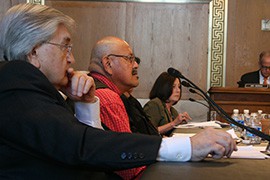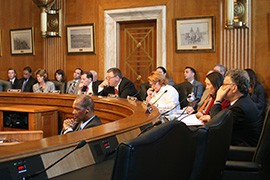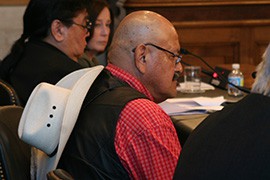- Slug: BC-CNS-Tribal Suicide,460
- Sidebar: Highlights of 2014 tribal youth report
- Photos available (thumbnails, captions below)
By AUBREY RUMORE
Cronkite News
WASHINGTON – In the six months since Christmas, 11 young people have committed suicide and another 379 have tried to do so on the Pine Ridge reservation, said Oglala Sioux Council member Collins Clifford.
“Whenever we lose one child, it hurts the spirit and the soul of every one of our people,” Clifford told the Senate Indian Affairs Committee.
He was testifying as part of a committee hearing on the “epidemic” rate of suicides among Native American youth, a rate that is 2.5 times the national average.
Even though the hearing was titled “Demanding Results to End Native Youth Suicides,” Sen. Heidi Heitkamp, D-North Dakota, said few results ever seem to filter out of the hearing room.
“Once again, here we are wringing our hands, telling horrible and deplorable stories,” Heitkamp said, adding that testimony of tribal youth suicides routinely shock the committee members hearing them.
The White House’s 2014 Native Youth Report listed suicide as the second-leading cause of death among Indian youth. That report, the most recent available on that demographic, pegged the suicide rate of tribal teens at more than double the national rate.
Those numbers were cited by Sen. John Barrasso, R-Wyoming, in his opening statement at the hearing.
“I will not stand idly by, nor will this committee,” Barrasso said.
Noting that the committee has held six hearings on the issue of Native youth suicide over the last 10 years, Barrasso said later in the hearing that, “Native youth suicide is not a new issue.”
He said that lowering the rate of suicide among Native youth “requires a comprehensive and evidence-based plan that is proactive instead of reactive.” But if there’s a plan in place to deal with the problem, it’s not working, Barrasso said to the acting director of the Indian Health Service.
Robert McSwain, the acting director, said that there has been a recent increase in coordinated efforts between the health service and tribal communities.
“We just have to make sure it’s always there,” McSwain said.
One program that has had success is a “culturally grounded” approach that focuses on “social, cultural and spiritual issues that may be more relevant in Native American youth suicide prevention,” said Teresa LaFromboise.
LaFromboise, a professor of developmental and psychological sciences at Stanford University, said that programs that focus “solely on psychological” issues are not as effective with Native youth.
She testified to the positive effect of cultural exposure on Native youth, saying many showed “less suicidal ideation and suicide attempts, less hopelessness, greater self-efficacy to manage anger and greater effectiveness in helping a suicidal friend solve problems.”
Whatever the solution, McSwain said, “We need to do more.”
Clifford said that duty to do more is “sacred.”
“Our youth are our future, and therefore are sacred,” he said.
^__=
Web Links:
_ White House’s 2014 Native Youth Report: https://www.whitehouse.gov/sites/default/files/docs/20141129nativeyouthreport_final.pdf
_ Committee hearing page: http://www.indian.senate.gov/hearing/oversight-hearing-demanding-results-end-native-youth-suicides
_ Clifford’s testimony: http://www.indian.senate.gov/sites/default/files/upload/files/6.24.15%20Witness%20Testimony%20-%20President%20Steele_0.pdf
_ McSwain’s testimony: http://www.indian.senate.gov/sites/default/files/upload/files/6.24.15%20Witness%20Testimony%20-%20Acting%20Director%20McSwain.pdf
^__=
SIDEBAR:
Grim picture of tribal teens
Among the findings of a 2014 White House report on Native youth:
– Their suicide rate is 2.5 times the national rate.
– Suicide is the second-leading cause of death for them.
– They are 70 percent more likely to be identified with emotional disturbances in schools.
– They have the highest rate of lifetime use of tobacco products, marijuana, nonmedical pain relievers and nonmedical prescription psychotherapeutics.
^__=
Acting Indian Health Service Director Robert McSwain, Oglala Sioux Councill member CJ Clifford and Stanford University Professor Teresa LaFromboise, from left, testify on the tribal teen suicides. (Photo by Aubrey Rumore)
The Senate Indian Affairs Committee hears testimony on suicide rates among Native American teens, which is 2.5 times higher than the national average, what one called an “epidemic” problem. (Photo by Aubrey Rumore)
Oglala Sioux Councill member CJ Clifford told Senate Indian Affairs Committee members that suicides by Native American youth “hurts the spirit and soul of our entire people.” (Photo by Aubrey Rumore)


